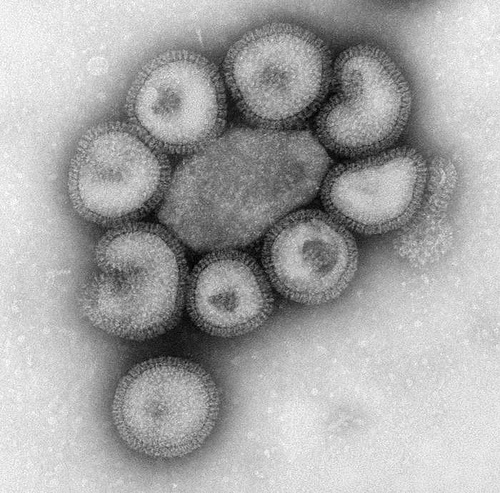
No higher resolution available.

|
This image was uploaded to the shared "Image Pool" and is usable on any CreationWiki site.
Please go to the Pool to edit its description.
|
Summary
Description: This negative-stained transmission electron micrograph (TEM) depicts the ultrastructural details of a number of influenza virus particles, or “virions”. A member of the taxonomic family Orthomyxoviridae, the influenza virus is a single-stranded RNA organism
The flu is a contagious respiratory illness caused by influenza viruses. It can cause mild to severe illness, and at times can lead to death. The best way to prevent this illness is by getting a flu vaccination each fall.
Every year in the United States, on average:
- 5% to 20% of the population gets the flu
- more than 200,000 people are hospitalized from flu complications, and
- about 36,000 people die from flu. Some people, such as older people, young children, and people with certain health conditions, are at high risk for serious flu complications.
Influenza A and B are the two types of influenza viruses that cause epidemic human disease. Influenza A viruses are further categorized into subtypes on the basis of two surface antigens: hemagglutinin and neuraminidase. Influenza B viruses are not categorized into subtypes. Since 1977, influenza A (H1N1) viruses, influenza A (H3N2) viruses, and influenza B viruses have been in global circulation. In 2001, influenza A (H1N2) viruses that probably emerged after genetic reassortment between human A (H3N2) and A (H1N1) viruses began circulating widely. Both influenza A and B viruses are further separated into groups on the basis of antigenic characteristics. New influenza virus variants result from frequent antigenic change (i.e., antigenic drift) resulting from point mutations that occur during viral replication. Influenza B viruses undergo antigenic drift less rapidly than influenza A viruses.
Copyright status
This image was published on flickr and is protected by the creative commons license http://creativecommons.org/licenses/by-nc-nd/2.0/deed.en
Source
http://www.flickr.com/photos/pingnews/434420191/
File history
Click on a date/time to view the file as it appeared at that time.
| Date/Time | Thumbnail | Dimensions | User | Comment |
|---|
| current | 22:52, 27 April 2008 |  | 500 × 493 (128 KB) | Mcastor | Description: This negative-stained transmission electron micrograph (TEM) depicts the ultrastructural details of a number of influenza virus particles, or “virions”. A member of the taxonomic family Orthomyxoviridae, the influenza virus is a single-st |
File usage
The following page uses this file:
This file contains additional information, probably added from the digital camera or scanner used to create or digitize it.
If the file has been modified from its original state, some details may not fully reflect the modified file.

